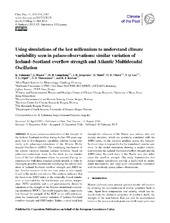| dc.contributor.author | Lohmann, Katja | eng |
| dc.contributor.author | Mignot, Juliette | eng |
| dc.contributor.author | Langehaug, Helene Reinertsen | eng |
| dc.contributor.author | Jungclaus, Johann H. | eng |
| dc.contributor.author | Matei, Daniela | eng |
| dc.contributor.author | Otterå, Odd Helge | eng |
| dc.contributor.author | Gao, Yongqi | eng |
| dc.contributor.author | Mjell, Tor Lien | eng |
| dc.contributor.author | Ninnemann, Ulysses Silas | eng |
| dc.contributor.author | Kleiven, Helga Flesche | eng |
| dc.date.accessioned | 2015-08-19T13:15:43Z | |
| dc.date.available | 2015-08-19T13:15:43Z | |
| dc.date.issued | 2015-02-10 | |
| dc.identifier.issn | 1814-9324 | en_US |
| dc.identifier.uri | https://hdl.handle.net/1956/10317 | |
| dc.description.abstract | A recent palaeo-reconstruction of the strength of the Iceland–Scotland overflow during the last 600 years suggests that its low-frequency variability exhibits strong similarity with palaeo-reconstructions of the Atlantic Multidecadal Oscillation (AMO). The underlying mechanism of the similar variation remains unclear, however, based on palaeo-reconstructions alone. In this study we use simulations of the last millennium driven by external forcing reconstructions with three coupled climate models in order to investigate possible mechanisms underlying the similar variation of Iceland–Scotland overflow strength and AMO index. Similar variation of the two time series is also largely found in the model simulations. Our analysis indicates that the basin-wide AMO index in the externally forced simulations is dominated by the low-latitude sea surface temperature (SST) variability and is not predominantly driven by variations in the strength of the Atlantic meridional overturning circulation (MOC). This result suggests that a large-scale link through the strength of the MOC is not sufficient to explain the (simulated) similar variation of Iceland–Scotland overflow strength and AMO index. Rather, a more local link through the influence of the Nordic seas surface state and density structure, which are positively correlated with the AMO index, on the pressure gradient across the Iceland–Scotland ridge is responsible for the (simulated) similar variation. In the model simulation showing a weaker correlation between the Iceland–Scotland overflow strength and the AMO index, the wind stress in the Nordic seas also influences the overflow strength. Our study demonstrates that palaeo-climate simulations provide a useful tool to understand mechanisms and large-scale connections associated with the relatively sparse palaeo-observations. | en_US |
| dc.language.iso | eng | eng |
| dc.publisher | Copernicus Publications | en_US |
| dc.rights | Attribution CC BY | eng |
| dc.rights.uri | http://creativecommons.org/licenses/by/3.0/ | eng |
| dc.title | Using simulations of the last millennium to understand climate variability seen in palaeo-observations: Similar variation of Iceland-Scotland overflow strength and Atlantic Multidecadal Oscillation | en_US |
| dc.type | Peer reviewed | |
| dc.type | Journal article | |
| dc.date.updated | 2015-08-19T13:12:02Z | |
| dc.description.version | publishedVersion | en_US |
| dc.rights.holder | Copyright 2015 The Authors | en_US |
| dc.identifier.doi | https://doi.org/10.5194/cp-11-203-2015 | |
| dc.identifier.cristin | 1179722 | |
| dc.source.journal | Climate of the Past | |
| dc.source.40 | 11 | |
| dc.source.14 | 2 | |
| dc.source.pagenumber | 203-216 | |

